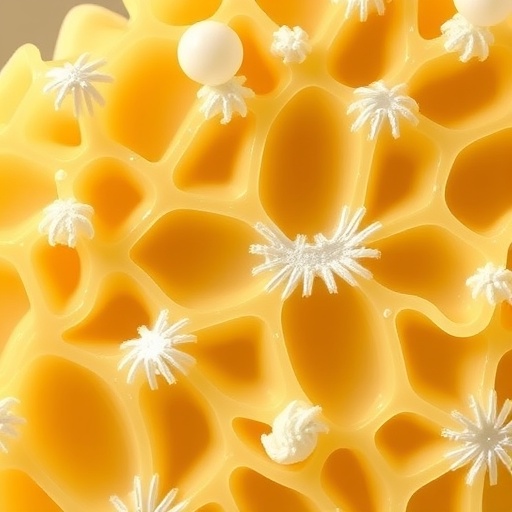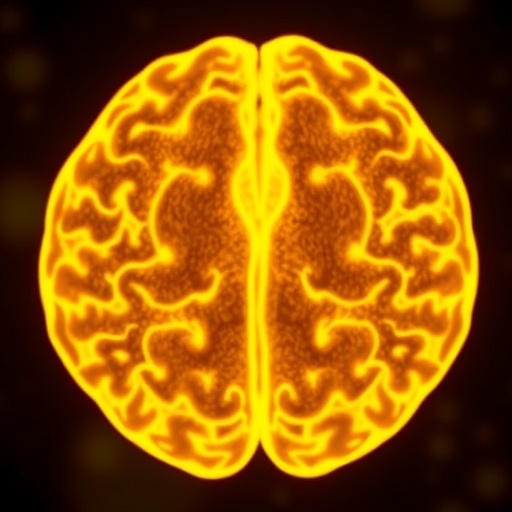In a groundbreaking advancement for cartilage tissue engineering, researchers have devised a new composite scaffolding material integrating chitosan, gelatin, and carrageenan. This innovative combination serves as a promising solution to the challenges faced by traditional methods in cartilage repair and regeneration. Cartilage, a resilient connective tissue found in various parts of the body, is notoriously difficult to heal once damaged due to its limited blood supply and poor regenerative capacity. The development of effective scaffolding materials is crucial in overcoming these barriers and finding viable solutions for cartilage injuries and degenerative diseases.
Chitosan, extracted from chitin, which is sourced from crustacean shells, holds significant promise in the biomedical field due to its biocompatibility, biodegradability, and anti-inflammatory properties. These unique characteristics render chitosan an excellent candidate for scaffolding development. The research team focused on harnessing these properties for efficient cartilage tissue regeneration, addressing a long-standing gap in orthopedic treatments. As ailments such as osteoarthritis become increasingly prevalent, the need for effective regenerative strategies has never been more pressing.
Gelatin, a derivative of collagen, complements chitosan in the composite material, providing enhanced mechanical properties and promoting cellular adhesion. The structural integrity provided by gelatin allows for a supportive environment, essential for encouraging cartilage cell proliferation and differentiation. This integration of chitosan and gelatin is aimed at maximizing the scaffolding functionality while optimizing the microenvironment necessary for chondrocyte functioning. The combination of these two materials reflects an iterative design process centered on biological compatibility and responsiveness.
Carrageenan, a polysaccharide derived from red algae, introduces an additional level of versatility to the scaffold. Known for its gelling properties, carrageenan enhances the hydrophilicity of the scaffolding material, thereby improving nutrient and oxygen diffusion. This is particularly relevant for cartilage regeneration, where nutrient access is essential for cell survival and matrix production. The interaction of these three components forms a highly bioactive and supportive environment intended to foster robust cartilage tissue growth and repair.
The research employed a series of evaluations, including in vitro and in vivo assessments, to evaluate the efficacy of the chitosan, gelatin, and carrageenan composite. These studies sought to monitor the mechanical properties, degradation rates, and biological activity of the material in simulated physiological environments. Metrics such as tensile strength and elasticity were considered critically, as the scaffold must withstand the dynamic loads experienced in real biological systems during normal joint movement.
In vitro studies demonstrated the scaffold’s success in promoting chondrocyte proliferation and matrix production, underscoring the material’s capability in mimicking natural cartilage conditions. Corresponding in vivo analyses revealed that when implanted in animal models, the scaffold supported cartilage regeneration effectively, highlighting its potential for practical applications in clinical settings. These findings are particularly encouraging, suggesting that the innovative composite material could serve as a viable option for treating cartilage defects in humans.
As the research progresses, the integration of such composite scaffolding materials may redefine standard practices in orthopedic medicine. By facilitating more effective tissue regeneration, it holds the promise to greatly enhance patients’ recovery and quality of life. This technological leap is essential, particularly as populations age and the incidence of cartilage-related ailments rises dramatically.
The implications of this research extend beyond merely addressing cartilage repair. Understanding the mechanisms of scaffold integration and improvement in pharmaceutical methods is crucial for advancing various areas of regenerative medicine. The strategies employed in designing such composite materials can inspire further innovations across different tissue engineering domains, including bone and nerve regeneration.
This pioneering work emphasizes the necessity of interdisciplinary collaboration, drawing from materials science, biology, and engineering to tackle complex healthcare challenges. As researchers continue to explore the properties of natural polymers and their composites, significant opportunities arise for enhancing therapeutic modalities and improving patient outcomes.
Moreover, the versatility of the chitosan/gelatin/carrageenan composite offers potential customization tailored to specific medical needs. The research team is optimistic that further modifications to the scaffolding materials can enhance their biocompatibility and application range, thereby capturing broader avenues of tissue engineering. Each advancement in this field potentially brings us closer to unlocking new solutions for long-standing medical challenges.
As the focus shifts toward improved patient-centric approaches, the refinements in scaffold design and material selection will become indispensable. Future studies are expected to delve deeper into optimizing the properties of chitosan, gelatin, and carrageenan, exploring alternative combinations and processing techniques. The goal remains to establish a standard protocol that can be readily translated into clinical practice, providing patients with effective treatments for cartilage defects.
In conclusion, the introduction of chitosan/gelatin/carrageenan composite scaffolding marks a promising new era in cartilage tissue engineering. With the potential to enhance regenerative capabilities and improve patient outcomes, this innovative research sets the stage for further explorations into advanced biomaterials. The work not only contributes to scientific understanding but also lays a foundation for future developments that may revolutionize orthopedic interventions, demonstrating the power of materials science in addressing pressing healthcare issues.
Subject of Research: Cartilage Tissue Engineering
Article Title: Chitosan/Gelatin/Carrageenan as a Composite Scaffolding Material for Cartilage Tissue Engineering
Article References:
Wang, C., Zhao, W., Ma, N. et al. Chitosan/Gelatin/Carrageenan as a Composite Scaffolding Material for Cartilage Tissue Engineering.
J. Med. Biol. Eng. (2025). https://doi.org/10.1007/s40846-025-00960-5
Image Credits: AI Generated
DOI: 10.1007/s40846-025-00960-5
Keywords: Cartilage, Tissue Engineering, Scaffolding Material, Chitosan, Gelatin, Carrageenan, Regenerative Medicine, Chondrocytes, Orthopedics.
Tags: anti-inflammatory properties of chitosanbiocompatible scaffolds for regenerationbiodegradable materials in medicinecarrageenan composite materialscartilage repair solutionscellular adhesion in cartilage scaffoldschitosan cartilage scaffoldinggelatin in tissue engineeringinnovative cartilage tissue engineeringmechanical properties of gelatinorthopedic treatments for osteoarthritisregenerative strategies for cartilage injuries





